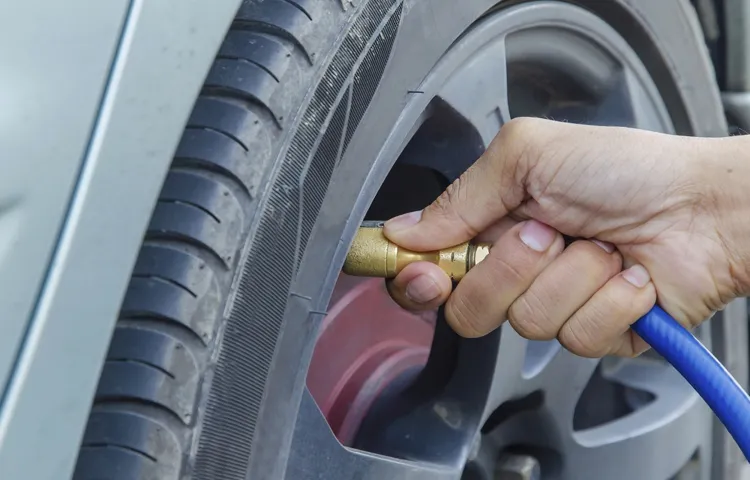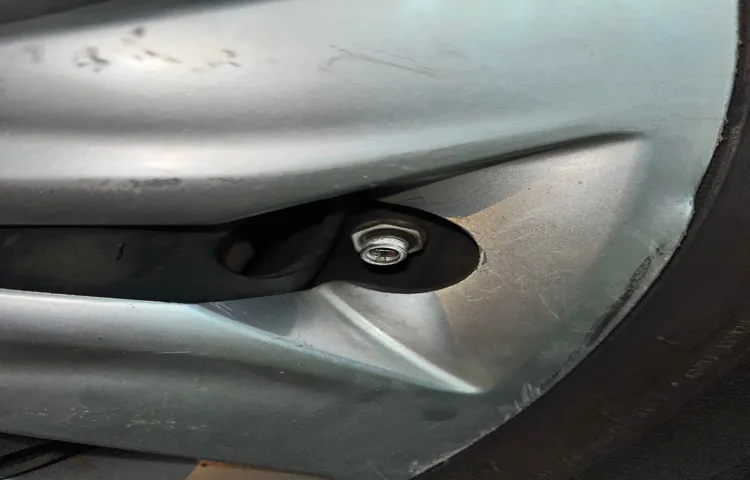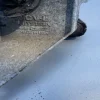Have you ever found yourself stranded on the side of the road with a flat tire and realized that your tire won’t fill with air no matter how hard you try? Frustrating, isn’t it? Well, you’re not alone. A flat tire can happen to anyone, and when you need to be somewhere urgently, it can be a real inconvenience. There are several reasons why your tire won’t fill with air, and in this blog post, we’ll explore some of the most common ones and tell you what to do about them.
So, sit tight, and let’s dive into the issue.
Table of Contents
Check for Leaks
If you’re wondering why your tire won’t fill with air, the first thing you should do is check for leaks. Even the tiniest puncture or crack in your tire can cause air to leak out, making it difficult to inflate. If you notice that your tire isn’t holding air as well as it used to, or you’re having to fill it up more frequently, it’s likely that there’s a leak present.
One way to check for leaks is to apply soapy water to the tire and look for bubbles forming. These bubbles indicate where air is escaping and will help you identify the location of the leak. Once you’ve found the leak, you can either patch it up yourself or take it to a professional to get it fixed.
Remember, it’s important to keep your tires inflated to the proper levels to ensure a smooth and safe ride, so don’t neglect any leaks you may find.
Inspect the Tire
When it comes to keeping your vehicle in optimal condition, checking for leaks should be a regular part of your routine. Inspecting the tire is an essential aspect of any vehicle maintenance, and checking for leaks is crucial in ensuring that your vehicle is safe to drive. Leaks can lead to flat tires and other issues that can impact your vehicle’s performance and even cause accidents.
To check for leaks, start by inspecting the tire for any foreign objects embedded in its surface. Look for screws, nails, or anything that may have punctured the tire. Next, check for any visible holes or cuts in the tire’s sidewall or tread.
If you spot any leaks or punctures, take your vehicle to a professional mechanic to check for any further damage or to repair the issue. By taking the time to inspect the tire regularly, you can help ensure that your vehicle runs smoothly and minimize the risk of any unfortunate accidents on the road.

Check the Valve Stem
When you’re checking your tire pressure, it’s important to also take a look at the valve stem. A damaged or leaking valve stem can cause your tire pressure to decrease rapidly, leading to a potential blowout or accidents on the road. Make sure to inspect the valve stem for any signs of damage, cracks or debris that may have gotten stuck inside.
You’ll also want to check if the valve cap is securely tightened to prevent any air from escaping. A simple visual inspection can detect leaks quickly, but if you’re unsure, you can always use a bit of soapy water to see if any bubbles form around the valve stem. If you do notice air escaping, head to your local mechanic to have the valve stem replaced as soon as possible.
Keep in mind that a quick check of the valve stem can save you from costly tire repairs or even worse accidents. So next time you’re checking your tires, don’t forget to give the valve stem a quick once-over to stay safe on the road.
Check the Air Pump
If your tire won’t fill with air, the first thing to check is the air pump. Sometimes, the air pump may be out of order, or the nozzle might not be attached correctly. It is also possible that the valve on the tire is damaged, preventing it from inflating properly.
In either case, it is important to take a close look at the pump and make sure you are using it correctly. You should also check the tire itself and ensure that it is in good condition and not too worn out. If you notice any damage or punctures in the tire, it is best to replace it before attempting to pump it up.
Remember, proper maintenance is key in keeping your vehicle running smoothly, so always be sure to check your tires regularly to avoid any potential road hazards.
Make Sure It’s Compatible
One of the crucial things to keep in mind while purchasing an air pump is to ensure compatibility. One of the first things to check when it comes to compatibility is the type of air pump you require for the specific purpose you have in mind. Some air pumps are suitable for aquariums, while others are for car tires, so it’s vital to choose the right one.
It’s also essential to check the power source for the air pump; some require an electrical outlet, while others use batteries. Additionally, it’s crucial to ensure that the air pump’s valves and fittings are compatible with your equipment. In conclusion, before purchasing an air pump, carefully consider the compatibility to ensure it works correctly and achieves the desired results.
Check for Debris or Blockage
When trying to figure out why your air pump isn’t working as it should, it’s crucial to check for debris or blockages in the system. Even the tiniest bits of dirt or debris can accumulate inside your air pump and cause it to stop functioning correctly. To fix the issue, it’s easy to clean the air pump by gently removing the pump’s cover and checking for any obstructions.
If you see any dirt or debris, simply clean your air pump using a soft cloth or a toothbrush. Remember, keeping your air pump clean and free from blockages will guarantee it works at maximum capacity, ensuring a steady stream of air through your aquaponics system. With proper maintenance, you can ensure your air pump functions correctly, providing your fish with the best possible water flow and ensuring their good health.
Inspect the Gauge
When it comes to maintaining your vehicle’s tires, checking the air pressure is a crucial part of the process. However, simply pumping air into your tires is not enough. You also need to inspect the gauge on your air pump to ensure that it is reading accurately.
A faulty gauge can provide inaccurate readings, which can lead to over-inflation or under-inflation of your tires, causing them to wear out more quickly or pose a safety hazard on the road. To check your gauge, you can use a tire pressure monitoring system (TPMS) or a tire gauge. Both tools will give you an accurate reading and help you determine whether you need to add or release air from your tires.
Remember, maintaining proper air pressure in your tires is vital for optimal performance, fuel efficiency, and safety on the road. So, check your air pump’s gauge regularly, and keep your tires inflated to the recommended pressure level to ensure a smooth and safe ride.
Preventing Future Issues
Have you ever experienced the frustrating issue of your tire not filling with air? It’s a common problem that can occur for various reasons. The most common reason is a puncture or leak in the tire. If this is the case, you may need to replace the tire entirely or get it patched up.
Another reason could be a problem with the valve stem, which can cause air to leak out or not fill up properly. In this case, the valve stem may need to be replaced. It’s also essential to make sure the tire pressure gauge is working correctly and that you are using the correct valve for your tire.
Preventing future issues with your tire can be done by regularly checking your tires for any signs of wear, keeping them properly inflated, and avoiding rough terrain that can damage them. If you’re ever unsure or can’t seem to fix the issue, it’s best to take your car to a professional mechanic to get it checked out.
Proper Tire Maintenance
Proper tire maintenance is crucial to prevent future issues with your vehicle and ensure your safety on the road. Neglecting your tires can result in uneven wear, low tread depth, and even blowouts. To avoid such situations, make sure to check your tire pressure regularly and inflate them to the recommended level.
Additionally, have your tires rotated and balanced every 6,000 miles or as recommended by your mechanic to ensure even wear. It’s also essential to visually inspect your tires for any signs of damage or wear, such as bulges, cracks, or punctures. In case of any damage, replacing your tire is the best option rather than risking your safety on the road.
By following these simple steps and keeping your tires in good shape, you can drive safely and avoid any future issues.
Avoid Over-Inflating
Over-inflating tires is a common mistake that can lead to future issues for your vehicle. When a tire is over-inflated, it puts excessive pressure on the tire and can cause it to become stiff and inflexible, increasing the likelihood of a blowout. It can also cause premature wear and tear on the tread, resulting in a shorter lifespan for the tire.
To avoid over-inflation, it’s important to check your tire pressure regularly and only inflate them to the recommended specification listed in your vehicle’s owner’s manual. Keeping your tires at the proper pressure will not only improve their longevity but also ensure a smoother, more efficient ride and save you money on gas in the long run. Remember, safety should always come first when it comes to your vehicle.
Conclusion
In conclusion, the reason why your tire won’t fill with air is simply for the same reason your ex won’t return your calls – there’s a leak. So, grab some soapy water, locate the puncture, and patch it up before your tire leaves you stranded just like your ex did. Remember, a little bit of maintenance goes a long way in both love and automotive care.
“
FAQs
What could be the possible reasons for my tire not to fill with air properly?
There could be several reasons such as a damaged tire valve, a puncture in the tire, a faulty air pressure gauge etc.
What should I do if I am unable to fill air in my tire even after putting in maximum effort using the air pump?
In such scenarios, you should take your vehicle to the nearest mechanic or tire shop to get it checked for any underlying issues.
Can over-inflation cause damage to my tire and affect my driving?
Yes, over-inflation can cause the tire to expand beyond its capacity, leading to decreased traction with the road and ultimately, causing a blowout which can be hazardous.
How often should I check for tire pressure and fill air accordingly?
It is recommended to check your tire pressure once every month and fill air to the recommended levels as mentioned in the vehicle’s manual.
Is it required to replace my tire valve stem frequently?
Generally, tire valve stem replacement is not required unless there is visible damage or wear and tear on the stem.
Can using an incorrect air pressure gauge damage my tire?
Yes, using an incorrect or damaged air pressure gauge can lead to under or over inflation of the tire and cause damage to it.
Can cold weather affect tire pressure and cause them to deflate?
Yes, during cold weather, tire pressure tends to decrease due to the contraction of air molecules inside the tire, leading to deflation.



